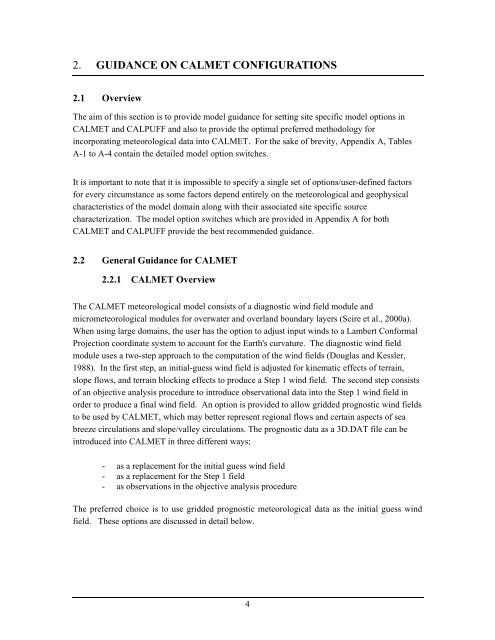Generic Guidance and Optimum Model Settings for the CALPUFF ...
Generic Guidance and Optimum Model Settings for the CALPUFF ...
Generic Guidance and Optimum Model Settings for the CALPUFF ...
Create successful ePaper yourself
Turn your PDF publications into a flip-book with our unique Google optimized e-Paper software.
2. GUIDANCE ON CALMET CONFIGURATIONS<br />
2.1 Overview<br />
The aim of this section is to provide model guidance <strong>for</strong> setting site specific model options in<br />
CALMET <strong>and</strong> <strong>CALPUFF</strong> <strong>and</strong> also to provide <strong>the</strong> optimal preferred methodology <strong>for</strong><br />
incorporating meteorological data into CALMET. For <strong>the</strong> sake of brevity, Appendix A, Tables<br />
A-1 to A-4 contain <strong>the</strong> detailed model option switches.<br />
It is important to note that it is impossible to specify a single set of options/user-defined factors<br />
<strong>for</strong> every circumstance as some factors depend entirely on <strong>the</strong> meteorological <strong>and</strong> geophysical<br />
characteristics of <strong>the</strong> model domain along with <strong>the</strong>ir associated site specific source<br />
characterization. The model option switches which are provided in Appendix A <strong>for</strong> both<br />
CALMET <strong>and</strong> <strong>CALPUFF</strong> provide <strong>the</strong> best recommended guidance.<br />
2.2 General <strong>Guidance</strong> <strong>for</strong> CALMET<br />
2.2.1 CALMET Overview<br />
The CALMET meteorological model consists of a diagnostic wind field module <strong>and</strong><br />
micrometeorological modules <strong>for</strong> overwater <strong>and</strong> overl<strong>and</strong> boundary layers (Scire et al., 2000a).<br />
When using large domains, <strong>the</strong> user has <strong>the</strong> option to adjust input winds to a Lambert Con<strong>for</strong>mal<br />
Projection coordinate system to account <strong>for</strong> <strong>the</strong> Earth's curvature. The diagnostic wind field<br />
module uses a two-step approach to <strong>the</strong> computation of <strong>the</strong> wind fields (Douglas <strong>and</strong> Kessler,<br />
1988). In <strong>the</strong> first step, an initial-guess wind field is adjusted <strong>for</strong> kinematic effects of terrain,<br />
slope flows, <strong>and</strong> terrain blocking effects to produce a Step 1 wind field. The second step consists<br />
of an objective analysis procedure to introduce observational data into <strong>the</strong> Step 1 wind field in<br />
order to produce a final wind field. An option is provided to allow gridded prognostic wind fields<br />
to be used by CALMET, which may better represent regional flows <strong>and</strong> certain aspects of sea<br />
breeze circulations <strong>and</strong> slope/valley circulations. The prognostic data as a 3D.DAT file can be<br />
introduced into CALMET in three different ways;<br />
- as a replacement <strong>for</strong> <strong>the</strong> initial guess wind field<br />
- as a replacement <strong>for</strong> <strong>the</strong> Step 1 field<br />
- as observations in <strong>the</strong> objective analysis procedure<br />
The preferred choice is to use gridded prognostic meteorological data as <strong>the</strong> initial guess wind<br />
field. These options are discussed in detail below.<br />
4

















